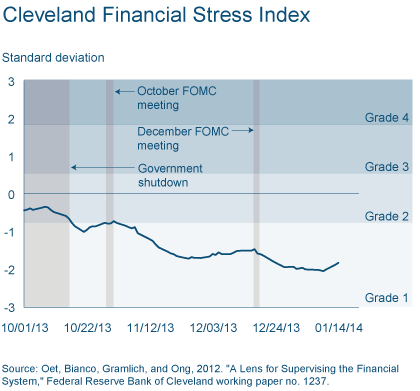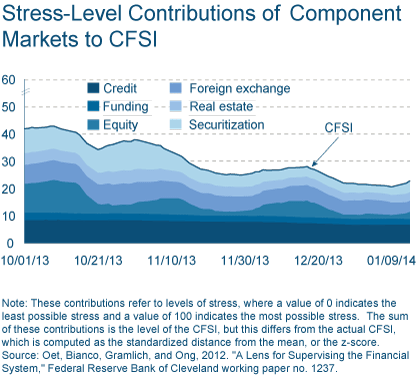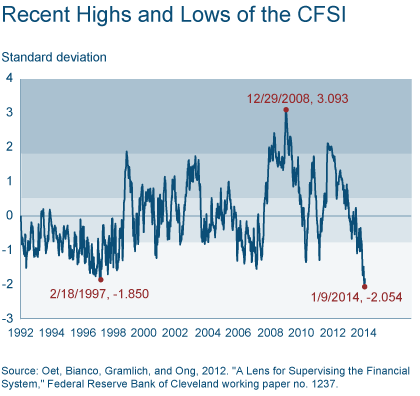Tracking Recent Levels of Financial Stress
Amanda Janosko
Federal Reserve Bank of Cleveland 01.17.14
The Cleveland Financial Stress Index (CFSI) has trended down throughout the fourth quarter of 2013 and early this year, indicating a reduction in the level of stress in the US financial system. During the federal government shutdown in October 2013, the CFSI was in Grade 2 or a “normal stress” period, but as the year progressed the index moved into Grade 1, indicating a “low stress” period. As of January 14, the index stood at −1.833, substantially below the CFSI’s historic high reading of 3.094 on December 29, 2008 and slightly above the CFSI’s historic low of −2.023 on January 9, 2014.
In addition to measuring the overall level of stress in the financial system, the CFSI can also tell us about the relative contributions of six different financial markets to overall systemic stress. Again, looking over the fourth quarter of 2013 and into the first quarter of 2014, we can see that all of the markets—credit, equity, funding, foreign exchange, securitization, and real estate—contributed to the reduction in stress. The equity and securitization markets experienced the most significant reductions in their contributions to stress, while the foreign exchange, credit, real estate, and funding markets experienced more moderate reductions.
The joint reduction in stress in all six financial markets led to a new historical low for the index on January 9, 2014. Previously, the lowest index reading had occurred in February 1997.
We can dive another level down into the factors contributing to stress by looking at the components that we track in each of these six financial markets. Stock market crashes, the only component in the equity market, reduced its contribution to stress by 85.2 percent during the fourth quarter of 2013. In the securitization market, the reduction in the residential-mortgage-backed-security spread drove the market’s overall reduced contribution to stress. Other notable components that helped drive the reduction in system stress include weighted dollar crashes, the commercial real estate spread, and the residential real estate spread. Note that the components responsible for the decline in overall stress share two characteristics; they contributed a large share to stress in the last quarter and their contribution has fallen significantly since. Some components, like the ABS spread, by contrast, show large percent change over the previous quarter but their contribution was very small to begin with.
Factors Contributing to Financial Market Stress
| Market | Component | Contribution to stress, 10/1/13 | Contribution to stress, 12/31/13 | Percent change |
| Equity | Stock market crashes | 10.613 | 1.567 | −85.2 |
| Securitization | Commercial MBS spread | 0.545 | 0.551 | 1.1 |
| Residential MBS spread | 7.795 | 2.490 | −68.1 | |
| ABS spread | 0.593 | 0.051 | 91.4 | |
| Real estate | Commercial real estate spread | 1.637 | 0.838 | −48.8 |
| Residential rela estate spread | 2.641 | 1.971 | −25.4 | |
| Foreign exchange | Weighted dollar crashes | 6.914 | 5.208 | −24.7 |
| Funding | Financial beta | 0.602 | 0.352 | −41.6 |
| Bank bond spread | 1.527 | 1.475 | −3.4 | |
| Interbank liquidity spread | 0.497 | 0.164 | −67.1 | |
| Interbank cost of borrowing | 0.139 | 0.125 | −9.8 | |
| Credit | Covered interest spread | 0.525 | 0.272 | −48.2 |
| Corporate bond spread | 2.950 | 2.152 | −27.0 | |
| Liquidity spread | 3.536 | 3.183 | −10.0 | |
| Commercial paper T-bill spread | 0.424 | 0.130 | −69.4 | |
| Treasury yield curve spread | 1.001 | 0.987 | −1.4 |
Note: “Contributions to stress” refers to levels of stress, where a value of 0 indicates the least possible stress and a value of 100 indicates the most possible stress. The sum of these contributions is the level of the CFSI, but this differs from the actual CFSI, which is computed as the standardized distance from the mean, or the z-score.
The Cleveland Financial Stress Index and all of its accompanying data are posted to the Federal Reserve Bank of Cleveland’s website at 3 p.m. daily. For a brief overview of how the index is constructed see this page.




